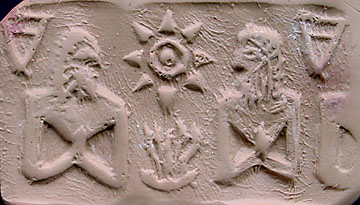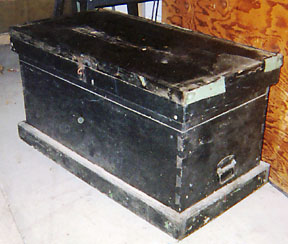|
is preliminary and subject to change. Please send all corrections and additions to the author. |
The Leroy Golf Antiquities Collection
A reconstuction of a collector’s life and antiquities collection

by Stephen Herold, M.A., Ph.C.
Leroy Golf was an American archaeologist (professional or amateur) who came from Oklaholma and worked in the oil industry in the Middle East in the 1930s and 1940s. While there he assembled a modest collection of artifacts that was exceptional both in its choice of subject and its quality. His specialty was seals, especially those depicting complex mythological scenes and unusual symbolism. He returned home around 1950 and died shortly thereafter. He had no family and only one close friend, a Mr. Henderson in Kansas who inherited his collection. Mr. Henderson died in 1974, and by that date the collection was carefully wrapped up and placed in a carpenter’s wooden chest in the attic (photo of chest below). Mrs. Henderson died in 2001 and the collection, along with the contents of the house, was then sold to a local second hand dealer. The items were sold by her on eBay or to other dealers in 2002 and 2003. Some of the original items sold on eBay have reappeared on the market within a few months.

The largest part of the collection is Sumerian sculpture and seals from the Jemdat Nasr period to early Old Babylonian, but with few distinctive Akkadian items, and none showing the common “contest scene” with animals. This points to an origin in a region throughly Sumerian and antithetical to Akkadian rule, and southern Sumeria was in near constant revolt from Agade. From the inscriptions, motifs and distinctive soil on some items these all seem to come from Ur, or somewhere nearby in the southern portion of Sumeria between Eridu and Erech. In the 1930s the University of Pennsylvania was funding excavations at Ur to help complete Woolley's work there, and Golf likely was involved. The Southern Irak oil fields where Mr. Golf would have worked are very close to Ur. Many of the Sumerian artifacts seem to be votive rather than personal, and may well come from a single find at a temple site.
The best of the remainder of the collection is Northern Mesopotamian or Syrian items, with a much larger percentage of stamp seals, and of the period 1800 B.C. (?) to 600 B.C. This is of overall lesser importance, but it includes a number of unusual types, including several so called “erotic” seals showing the naked goddess Ishtar. Another important Syrian piece is a c. 700 B.C. stamp seal with the Luwian-Hittite hieroglyphic character for “city” inscribed on the top — a very late usage of such hieroglyphics. There also is a Tell Brak occulus figure , all of which come from the region between Mosul and Syria. As with the Sumerian items, this area is also a major oil producing area where Golf likely worked, and in the late 1930s Sir Leonard Woolley had moved his “dig” to northern Syria. Some of the Golf Syrian and Egyptian items have surviving excavation numbers dating to the late 1930s, which also hints at a possible connection between Golf and Woolley at this time. As I understand it Woolley’s excavations were quite a fashionable thing in the 1930s, and all kinds of people visitied, or became connected with the projects in some way.
Finally there were a number of Egyptian items that are much more common — primarily scarabs and ushabtis. The exception is a historically very important cylinder seal of c. 1800 B.C., issued by Amenemhat III to the Nomarch of Habenu, the 14th Nome of Lower Egypt (on the border where the Horus Road to Asia began). Many of the Egyptian items show distinct Palestinian or Middle Eastern influences, and they all may have come from a transitional Egyptian-Asian area such as the 14th Nome. Some also may have come from antique dealers, and a noted American dealer has questioned the antiquitity of some of the Egyptian items, so care is called for in judging them. There also was a reference library attached that contained 12 volumes of Maspero and other books.
This collection is one of the few still completely unknown to scholars, and dates from the last period in which the purchase and export of antiquities was still legal. It was assembled at the same time as the famous Moore and Erlenmeyer collections, and with an equally critical eye, but without the expert advice available to wealthy collectors and public institutions. As with these famous collections provenance, except for the known areas of Mr. Golf'’s employment, is entirely conjectural and analytically derived by scholars. The easy manner of acquiring such items is best illustrated by a remark by Edward Chiera in his book They Wrote on Clay about the dig at Ur: “One day a guest, a British architect, found in the refuse dump a baked brick dating about 2200 B.C. He wanted to keep it; and, since the inscription stamped upon it was so common as to be of no scientific interest, it was given to him.”
Golf’s carefully chosen selection of objects is a wonderful record of the early days of archaeology, and of the important collections that brought wide spread awareness of the ancient world. Some of his purchases are definitely genuine artifacts; others seem to have been “improved” or are vintage modern reproductions. The museum collections at the British Museum, the Louvre, the NY Metropolitan and so many others were assembled from the same supply of material and at the same time, and even these great collections have found non-ancient items on closer inspection of their holdings. It is unfortunate that we lack precise excavation data for so many fine items, but they also tell a rich, pictorial story by themselves.
The links below will take you to the different parts of the Golf Collection. The tentative identifications have been done by a number of scholars and dealers, and are based on experience and comparison to published examples. Any additions or corrections would be greatly appreciated by the author (email at the bottom of this page). Please excuse the poor quality of some of the photos, but only inventory photos exist for some things that sold quickly, or none at all. It was hoped to examine the entire collection and assign item numbers in roughly chronological sequence, but some identifications are uncertain, and new items keep appearing, so the numbers are merely a serial cataloging identification. They will, despite their catalog numbers, ultimately be arranged on these web pages in approximate chronological order.
These pages are an exercise to see how much can be learned about, and from, such an ephemeral and undocumented collection. Owing to the volume and variety of material it has been slow to organize and validate the pieces, although some definite answers came easily. In other historical analyses it is often adequate to ascertain one definite fact in order to enrich historical understanding. The Justinian trimissus (described in another article at Antiques AtoZ) recently found off Ermine Street, by its very presences confirms more and more valuable trade in early Anglo-Saxon England than often thought. Here much more is potentially possible. I am no Sumerian specialist (being a palaeographer and epigraphic historian, originally of early Celtic manuscripts), so my descriptions are largely based on printed comparisons and opinions of other scholars. They seem to be what they are described as, lacking any contrary evidence, except where noted. This site will be updated as information becomes known.

